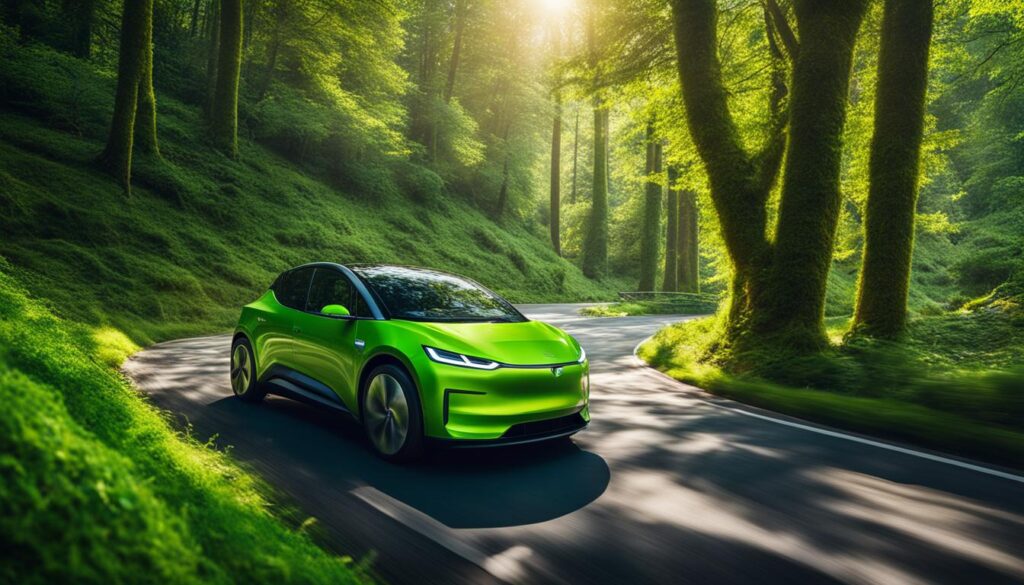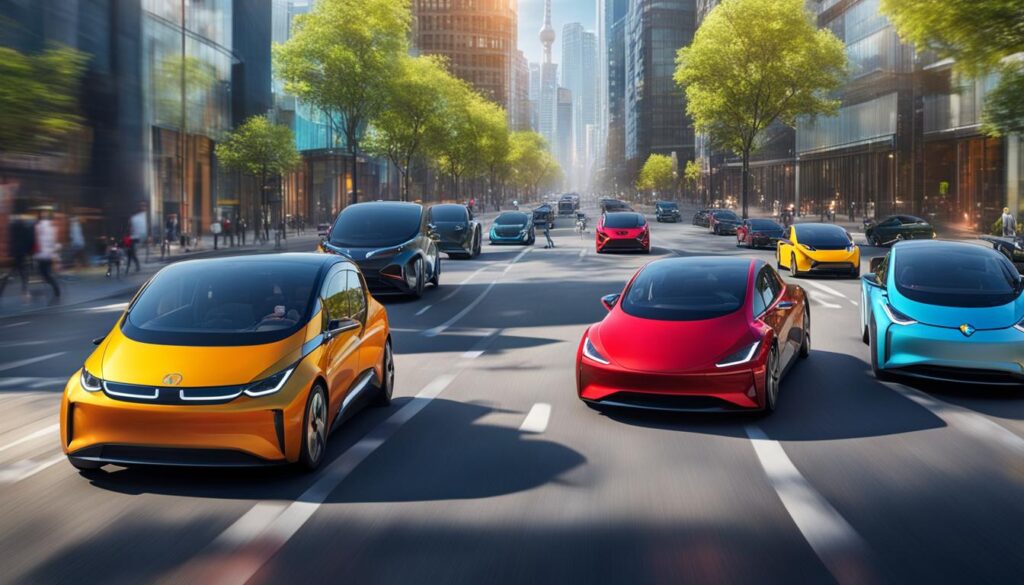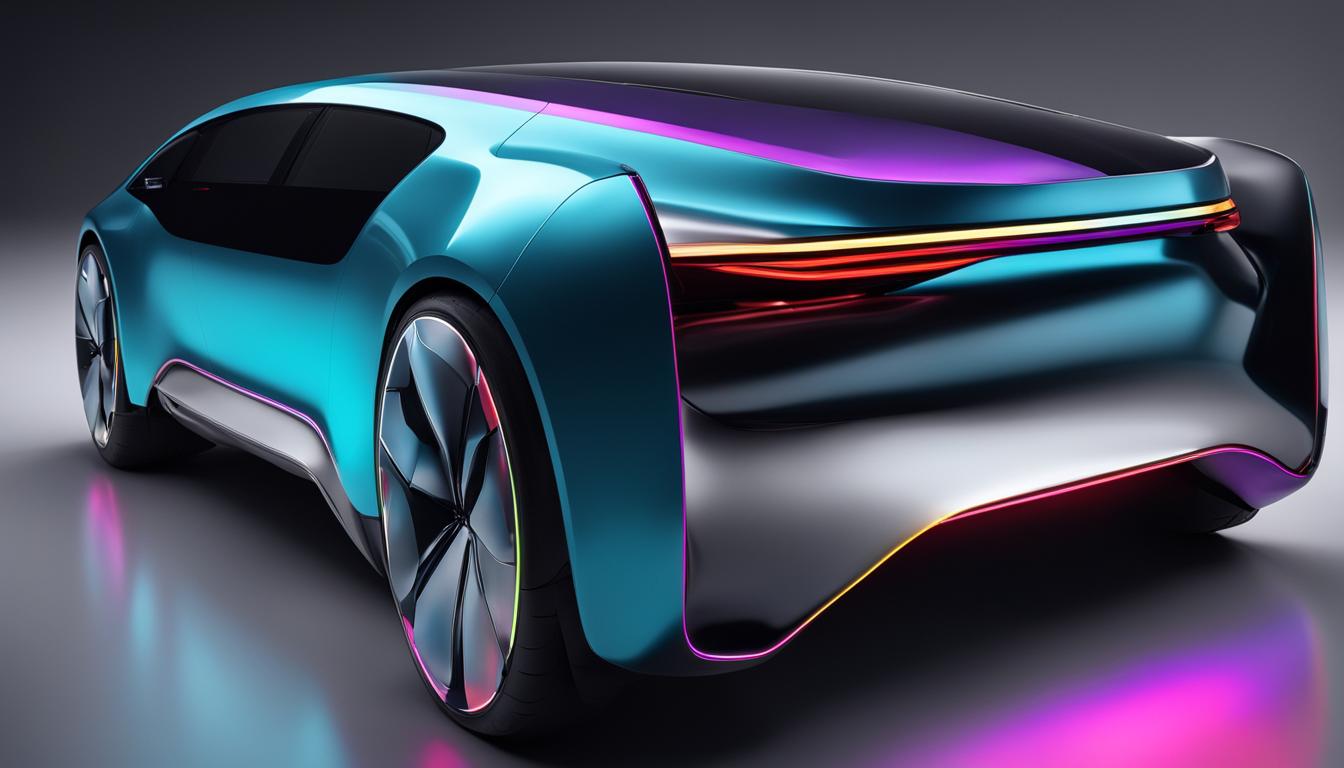The Future of Electric Vehicles: Trends and Innovations
As the world strives for sustainable transportation, electric vehicles (EVs) are taking center stage as a viable and efficient alternative to gas and diesel vehicles. Thanks to constant innovations in battery technology, increased charging infrastructure, and the development of autonomous driving, the future of EVs is brighter than ever before.
In this article, we’ll explore the major trends and innovations driving the EV industry forward, including advancements in battery technology, expanding charging infrastructure, the rise of autonomous EVs, the environmental benefits of EVs, and key challenges to the EV industry. We’ll also examine the increasing adoption of EVs by consumers and businesses alike, as well as the latest developments in EV design and technology.
Key Takeaways:
- The future of EVs is promising, with constant innovations in battery technology, charging infrastructure, and autonomous driving
- EVs offer significant environmental benefits, including reducing greenhouse gas emissions and air pollution
- Expanding charging infrastructure is essential for the widespread adoption of EVs
- The EV industry faces challenges such as range anxiety, charging infrastructure limitations, and the need for standardized regulations
- EVs provide an opportunity to achieve sustainable transportation and promote a greener future
Evolving Electric Vehicle Technology The Future of Electric Vehicles: Trends and Innovations
The development of electric vehicle technology has come a long way since its early days. One of the most significant advances has been in electric vehicle batteries. With improvements in battery technology, the range of electric vehicles has increased, and charging times have become faster than ever before. In addition to these benefits, advances in battery production have also led to lower costs, making electric vehicles more accessible to the general public.
The introduction of solid-state batteries, which use solid electrolytes instead of liquid ones, shows even more promise for the future of electric vehicles. These batteries have the potential to be lighter, more efficient, and safer than traditional lithium-ion batteries. They could also significantly increase the driving range of electric vehicles.
“With improvements in battery technology, the range of electric vehicles has increased, and charging times have become faster than ever before.”
Another area of electric vehicle technology that is seeing rapid progress is autonomous driving. Many electric vehicles currently on the market already offer some level of autonomous features, such as self-parking, lane-keeping assistance, and collision avoidance. These features are made possible by the use of advanced sensors and software.
The integration of electric vehicle technology with autonomous driving presents exciting opportunities for the future. Eventually, we may see fully autonomous electric vehicles that are capable of safely transporting passengers with no human input required.
Expanding Charging Infrastructure
Electric vehicles are quickly gaining popularity due to their environmental benefits and cost savings on fuel. However, the lack of a robust charging infrastructure has been a major deterrent for potential buyers. That’s why charging infrastructure expansion is crucial for the widespread adoption of electric vehicles.
The current state of charging infrastructure leaves much to be desired, with limited charging stations available in many areas. To address this issue, efforts are being made to expand the infrastructure with the installation of public charging stations and advancements in wireless charging technology.
Some of the major players in the industry are taking charge, with Tesla leading the way by establishing a network of Supercharger stations across the country. Additionally, major automakers such as Ford and General Motors are also investing heavily in charging infrastructure in order to promote the adoption of electric vehicles.
The expansion of charging infrastructure not only benefits electric vehicle drivers but also has a positive impact on the environment. By providing more charging options, it encourages more people to switch to electric vehicles, resulting in a reduction of fossil fuel consumption and greenhouse gas emissions.
In conclusion, the expansion of charging infrastructure is a vital component in the growth of the electric vehicle industry. As more efforts are made to expand the infrastructure, it is expected that electric vehicles will become a more viable and convenient option for all drivers.
The Rise of Autonomous Electric Vehicles
Autonomous electric vehicles (AEVs) combine two of the most significant technological advancements in the automotive industry. AEVs have the potential to revolutionize transportation by providing increased safety and efficiency while also minimizing environmental impact. AEVs use a combination of sensors and software to control the steering, acceleration, and braking of the vehicle, allowing for a more intuitive and intelligent driving experience.
One of the most significant benefits of AEVs is their potential to reduce the number of fatalities and injuries caused by human error. According to the National Highway Traffic Safety Administration, 94% of car accidents are the result of human error. AEVs eliminate driver error and increase safety through their advanced sensors and real-time monitoring systems.
AEVs also have the potential to improve traffic flow, reduce congestion, and increase efficiency by optimizing routes and minimizing traffic jams. This optimization is achieved through the use of real-time data and predictive analytics, allowing for more optimal routing and scheduling. With the growing demand for seamless and efficient transportation, AEVs are poised to become an integral part of the transportation landscape.
Current Developments
The development of AEVs is a fast-evolving field, with significant investments from industry leaders such as Tesla, Google, and General Motors. Tesla is currently developing a fully autonomous electric semi-truck, while Google’s Waymo is testing its AEV technology in Arizona. General Motors is also developing autonomous electric cars and is set to release its first AEV, the Cadillac Lyriq, in 2022.
With increasing development and investment in AEV technology, it is clear that AEVs will continue to shape the future of transportation. While there are still obstacles to overcome, such as the need for standardized regulations and widespread charging infrastructure, the potential of AEVs to transform transportation is undeniable.
Environmental Benefits of Electric Vehicles
Electric vehicles (EVs) have a significant positive impact on the environment. By using clean energy to power EVs, greenhouse gas emissions and air pollution can be considerably reduced.
According to a study by the Union of Concerned Scientists, even when taking into account the emissions generated during the production of an EV and its battery, EVs produce fewer emissions overall compared to traditional gasoline cars. This is largely due to the fact that EVs run on electricity, which can be generated from renewable sources like solar and wind power.

Furthermore, as more renewable energy sources are integrated into the power grid, the environmental benefits of EVs will continue to increase. A transition to EVs and renewable energy could also reduce the dependence on fossil fuels and help lessen the negative impacts of climate change.
Another environmental benefit of EVs is their overall efficiency. EVs are able to convert up to 77% of the energy stored in batteries into motion, compared to only about 12–30% for gasoline vehicles. This higher efficiency translates into less wasted energy and fewer emissions.
Overall, the environmental benefits of EVs make them an important step towards a more sustainable and green future.
Sustainable Transportation for a Greener Future
As the transportation industry continues to evolve, there is a growing need for sustainable alternatives that can help reduce greenhouse gas emissions and minimize environmental impact. That’s where electric vehicles come in.
Electric vehicles are paving the way for a greener future by reducing dependence on fossil fuels and providing a cleaner mode of transportation. Not only do they help improve air quality and mitigate climate change, but they also have the potential to integrate with renewable energy sources for a more sustainable transportation system.
In fact, sustainable transportation is a key goal of many cities and municipalities around the world. By investing in green transportation options such as electric vehicles and public transportation, communities can reduce traffic congestion, improve air quality, and create a more livable environment for residents.
“Electric cars are a critical part of our effort to combat climate change and air pollution.” – Gina McCarthy
As the demand for sustainable transportation continues to grow, it’s important that we continue to invest in electric vehicle technology and expand charging infrastructure to make EVs a viable option for all drivers. By doing so, we can pave the way for a cleaner, greener future for generations to come.
The Growing Adoption of Electric Vehicles
The electric vehicle industry has seen a remarkable rise in recent years, as more and more consumers and businesses recognize the numerous benefits of electric vehicles. In 2020, despite the global pandemic, electric vehicle sales increased by 43% compared to the previous year, with a total of 3.2 million EVs sold worldwide. The trend is set to continue, with industry experts predicting that electric vehicles will account for over 50% of new car sales by 2030.
One of the main factors driving the growing adoption of electric vehicles is government incentives. Across the world, governments are introducing policies to encourage the use of electric vehicles, such as tax rebates, subsidies, and grants for purchasing EVs, as well as funding for the development of charging infrastructure.
| Country | Government Incentives |
|---|---|
| United States | Incentives of up to $7,500 for purchasing EVs |
| China | Subsidies of up to 50% of the purchase price for certain EV models |
| Germany | Up to €9,000 in incentives for purchasing EVs, as well as funding for charging infrastructure development |
Technological advancements have also contributed to the increased popularity of electric vehicles, with improvements in battery technology leading to longer ranges and faster charging times. In addition, consumers are becoming more aware of the environmental benefits of EVs, such as reduced greenhouse gas emissions and improved air quality.

Another significant factor driving the growing adoption of electric vehicles is changing consumer preferences. As individuals become more environmentally conscious, many are choosing to purchase electric vehicles as a way to reduce their carbon footprint and contribute to a more sustainable future. In addition, the convenience and cost savings associated with electric vehicles are appealing to a wide range of consumers.
Emerging Trends and Innovations in the Electric Vehicle Industry
The electric vehicle industry is constantly evolving, with new developments and innovations shaping the future of transportation. Here are some of the latest trends:
- New Models and Designs: Electric vehicle manufacturers are continually introducing new models with sleek and modern designs that challenge traditional gasoline-powered vehicles.
- Innovative Features: Electric vehicles now come with a range of innovative features, such as regenerative braking, energy-saving modes, and sophisticated infotainment systems.
- Connectivity Options: Many electric vehicles now offer seamless connectivity with smartphones and other devices, allowing for remote control and monitoring of vehicle functions.
- Integration of Electric Vehicles into Smart Cities: With the rise of smart cities, electric vehicles are being integrated into urban transportation systems, with dedicated charging stations and other infrastructure being developed to support their use.
- Advancements in Battery Technology: Electric vehicle manufacturers are investing heavily in battery research, with new developments driving longer range, faster charging times, and increased efficiency.
“The electric vehicle industry is experiencing a period of rapid change, and these emerging trends and innovations represent just a small portion of the developments driving the industry forward.”
Overcoming Challenges in the Transition to Electric Vehicles
The shift to electric vehicles is not without its challenges. One of the biggest obstacles faced by the electric vehicle industry is the issue of range anxiety, or the fear of running out of power during a trip. This fear can be attributed to the limited range of electric vehicles compared to traditional gasoline vehicles. However, advancements in battery technology and the expansion of charging infrastructure have greatly reduced this concern.
Another challenge that must be overcome is the limitations of charging infrastructure. While the network of public charging stations is growing rapidly, there are still gaps in the coverage that need to be addressed. This issue is particularly prevalent in more rural areas where charging stations are less common. The further development of charging infrastructure is essential to ensuring that electric vehicles can be used for long trips without disruption.
Furthermore, there is a need for standardized regulations to ensure a seamless transition from traditional combustion engines to electric vehicles. This includes regulations related to charging infrastructure, safety features, and battery disposal. Standardization would remove ambiguity and create a level playing field for all manufacturers, making it easier for consumers to adopt electric vehicles.
In short, the transition to electric vehicles is not without challenges, but the industry has made significant progress in addressing them. With advancements in battery technology, the expansion of charging infrastructure, and the establishment of standard regulations, the transition to electric vehicles can be seamless and successful.
The Future Outlook for Electric Vehicles
The future of EVs is looking brighter than ever. With advances in technology and a growing focus on sustainability, electric vehicles are poised to become the future of transportation.
One major trend that is expected to shape the future of EVs is the continued development of more efficient and cost-effective batteries. As battery technology improves, range anxiety will become less of a concern, and EVs will be able to travel further on a single charge while charging times will continue to decrease.
Another trend to watch out for is the expansion of charging infrastructure. Governments and private companies are investing heavily in building new charging stations, and wireless charging technology is becoming more widespread.
Autonomous electric vehicles are also expected to become more prevalent in the future. As technology continues to develop, EVs will become more integrated with autonomous features, leading to increased safety, convenience, and efficiency on the roads.
The emergence of electric vehicles also brings important environmental benefits. With a reduction in greenhouse gas emissions and a decrease in air pollution, EVs have the potential to revolutionize the transportation industry and play a major role in combating climate change.
In conclusion, the future of electric vehicles is full of promise. With continued advancements in technology, expanded charging infrastructure, and a focus on sustainability, electric vehicles are set to become the transportation mode of the future.
Key Innovations Driving the Future of Electric Vehicles
Electric vehicles are rapidly evolving as technology advances, and innovations are driving the future of EVs like never before. Let’s explore some of the key EV innovations that are shaping the future of sustainable transportation:
Vehicle-to-Grid Integration
One of the most exciting innovations in the EV industry is vehicle-to-grid (V2G) integration. This technology allows electric vehicles to send electricity back to the grid when not in use, providing a valuable source of energy storage for the electrical grid while also benefiting EV owners through reduced charging costs and potential income generation. With improvements in battery technology and the growth of smart grid infrastructure, V2G integration could revolutionize the EV industry’s role in the energy grid.
Advanced Driver-Assistance Systems
Advanced driver-assistance systems (ADAS) are another key innovation driving the future of electric vehicles. These systems use sensors, cameras, and radar to enhance safety and driver comfort by assisting in steering, acceleration, and braking. ADAS also enables semi-autonomous driving, improving driving safety and efficiency and bringing automakers ever closer to fully autonomous electric vehicles.
Improved Battery Management Systems
Battery management systems (BMS) are essential components in electric vehicles’ design that regulate the battery’s state of charge and performance. Innovations in BMS technology are driving improvements in EV battery lifespan, charging speed, and storage capacity. Additionally, the incorporation of artificial intelligence and machine learning in BMS could provide even more advanced control over battery performance, enabling EVs to achieve even greater efficiency in the future.
Materials Research for Lightweight and Efficient EV Components
The search for lightweight and efficient EV components is driving innovation in materials research, facilitating the development of EVs with improved range and performance. Researchers are exploring the use of composites and advanced metals, including magnesium, aluminum, and carbon fiber-reinforced polymers, to improve EVs’ energy efficiency and reduce their weight and cost.
These innovations represent only a few examples of how advanced technology is driving the electric vehicle industry forward. As these innovations continue to evolve, they will undoubtedly shape the future of sustainable transportation and create a more sustainable and greener future.
Conclusion
In conclusion, the electric vehicle industry is rapidly evolving, with new technologies and innovations driving the future of sustainable transportation. The advancements in electric vehicle technology, from battery improvements to wireless charging infrastructure, have made electric vehicles more appealing to consumers and businesses, contributing to the rise in EV adoption.
However, there are still challenges to be addressed, such as range anxiety and charging infrastructure limitations. Government incentives and standardized regulations can help overcome these obstacles, ensuring a seamless transition from traditional combustion engines to electric vehicles.
Looking ahead, the future of electric vehicles is promising. With continued investment in research and development, the potential for vehicle-to-grid integration, improved battery management systems, and advanced driver assistance systems, electric vehicles are poised to revolutionize the transportation industry.
It is crucial for individuals and organizations to stay up-to-date with the latest trends and innovations in the electric vehicle industry to contribute to a more sustainable and greener future.
FAQ
What are some current trends and innovations in the electric vehicle industry?
The electric vehicle industry is experiencing rapid growth, with several trends and innovations shaping its future. Some of the key trends include advancements in electric vehicle technology, the expansion of charging infrastructure, the rise of autonomous electric vehicles, and the increasing adoption of electric vehicles by consumers and businesses.
How has electric vehicle technology evolved in recent years?
Electric vehicle technology has evolved significantly in recent years. There have been notable advancements in battery technology, resulting in longer range, faster charging times, and improved efficiency in electric vehicles. These advancements have contributed to the increased popularity and viability of electric vehicles as a sustainable transportation option.
What is the importance of expanding charging infrastructure for electric vehicles?
A robust charging infrastructure is crucial for the widespread adoption of electric vehicles. It ensures that EV owners have convenient access to charging stations, reducing range anxiety and increasing the overall convenience of owning an electric vehicle. Efforts are being made to expand the charging infrastructure, including the installation of public charging stations and advancements in wireless charging technology.
How are autonomous vehicles and electric vehicles connected?
Autonomous technology and electric vehicles are interconnected, as both have the potential to revolutionize the transportation industry. The rise of autonomous electric vehicles promises increased safety, efficiency, and reduced congestion on the roads. Companies are actively developing and testing self-driving electric vehicle technologies to bring about the next generation of transportation.
What are the environmental benefits of electric vehicles?
Electric vehicles offer several environmental benefits. They produce zero tailpipe emissions, which helps reduce air pollution and improve air quality. By transitioning to electric vehicles and integrating with renewable energy sources, we can significantly reduce greenhouse gas emissions, combat climate change, and create a more sustainable transportation system.
How do electric vehicles contribute to sustainable transportation?
Electric vehicles are a key component of sustainable transportation. By reducing the dependence on fossil fuels and minimizing environmental impact, electric vehicles help promote greener and more sustainable modes of transportation. With advancements in electric vehicle technology and the expansion of charging infrastructure, they are becoming a viable and sustainable alternative to traditional combustion engine vehicles.
Why are electric vehicles gaining popularity?
Electric vehicles are gaining popularity for several reasons. Government incentives, technological advancements, and changing consumer preferences have played a significant role in the adoption of electric vehicles. As the industry continues to evolve, electric vehicles are becoming more affordable, reliable, and convenient, making them a desirable choice for many consumers and businesses.
What are some of the latest developments in the electric vehicle industry?
The electric vehicle industry is experiencing constant innovation. Some of the latest developments include the introduction of new models and designs, innovative features such as advanced driver-assistance systems, connectivity options, and the integration of electric vehicles into smart cities. These developments are paving the way for a more efficient and interconnected future of transportation.
What challenges are faced in the transition to electric vehicles?
The transition to electric vehicles is not without its challenges. Range anxiety, which refers to the fear of running out of battery power, is a common concern for potential EV owners. Additionally, the availability and accessibility of charging infrastructure are crucial for ensuring a smooth transition. Standardized regulations and policies are also needed to address issues related to vehicle electrification and support the growth of the electric vehicle industry.
What does the future hold for electric vehicles?
The future of electric vehicles looks promising. With ongoing advancements in technology and increasing awareness about the environmental benefits, electric vehicles are expected to play a significant role in transportation systems worldwide. As we move towards a greener future, the adoption of electric vehicles is likely to continue growing, bringing about a more sustainable and environmentally friendly transportation system.
What are some key innovations driving the future of electric vehicles?
Several key innovations are driving the future of electric vehicles. These include vehicle-to-grid integration, which allows EVs to store and provide excess energy to the grid; advanced driver-assistance systems that enhance safety and convenience; improved battery management systems for increased efficiency; and materials research focused on creating lightweight and energy-efficient EV components. These innovations are shaping the future of electric vehicles and paving the way for a more sustainable and efficient transportation system.







